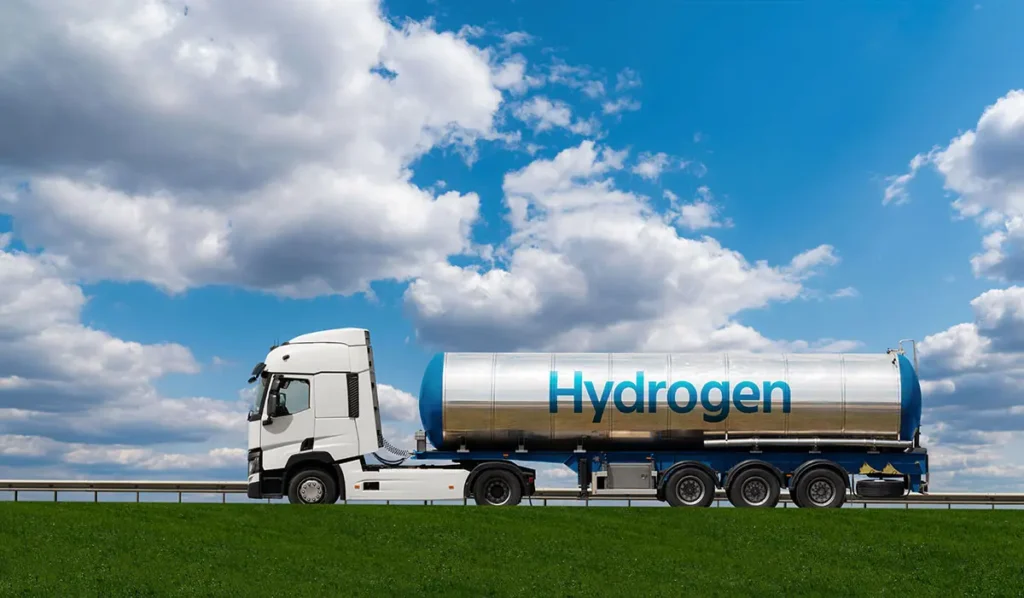Why is hydrogen storage so important?
One of hydrogen’s greatest strengths is its ability to store energy for long periods. Unlike electricity, which must be used or lost, hydrogen can be produced when energy is abundant (for example, during peaks in renewable energy production) and stored for later use when demand is higher. This makes hydrogen a key energy carrier in the transition toward a decarbonized economy.
Main methods of hydrogen storage
Storing hydrogen is no small task. It is a light, small and a highly flammable gas that requires specific conditions to be stored safely. Here are the primary storage methods used today:
Storage in high-pressure gas form: The most common method involves compressing hydrogen into gas at very high pressure (up to 900 bar) in specially designed tanks. This technique is already used for refueling hydrogen vehicles.
Advantages: This method is relatively simple and well understood, with tanks available in various sizes, offering flexibility.
Disadvantages: The main drawback is the need for robust and costly tanks to withstand high pressures. Additionally, compressing hydrogen consumes energy, reducing system efficiency. At a large scale, using bulky infrastructure could become a logistical and economic challenge.
Storage in liquid form at extremely low temperatures:️ Another method involves cooling hydrogen to extremely low temperatures (around -253°C) to liquefy it. Liquid storage allows more hydrogen to be concentrated in a smaller volume compared to gas storage. Advantages: Liquid storage is highly energy-dense, making it especially useful for applications requiring large amounts of hydrogen in limited space, such as maritime or better in aerospace transportation.
Disadvantages: The liquefaction process is energy-intensive and expensive. Additionally, maintaining hydrogen at such low temperatures requires advanced thermal insulation, which complicates and increases the cost of storage with expected H2 losses due to boil-off
Storage in solid materials: Storing hydrogen in solid materials, such as metal hydrides, is an emerging technology. These materials absorb hydrogen like a sponge and release it on demand.
Advantages: This method offers increased safety since hydrogen is trapped in a solid, reducing the risk of explosion or leakage. It also allows storage at low pressure and ambient temperature.
Disadvantages: The technology is still under development and remains expensive. The materials used to store hydrogen can be heavy and bulky, limiting their use in certain applications.
Storage in liquid carriers: Hydrogen can also be stored in liquid carriers, known as liquid hydrogen carriers (LHCs), which bind hydrogen chemically in a stable liquid compounds. This facilitates transportation and storage at ambient temperature and pressure. Hydrogen is released when needed through chemical reactions.
Advantages: This method reduces the risks associated with high-pressure storage and allows for the use of existing liquid transportation infrastructure. It is also easier to handle than compressed gas and more adapted for large H2 quantities
Disadvantages: Converting hydrogen to and from a liquid carrier requires energy, impacting efficiency. Additionally, some carriers may require complex chemical processing, raising costs and technical challenges.
How to distribute hydrogen efficiently and safely?
Once stored, hydrogen must be transported to where it will be used, whether for fueling vehicles, powering factories, or integrating into energy grids. Hydrogen distribution presents its own challenges, particularly regarding safety and efficiency.
Pipeline transportation: One of the most efficient ways to transport large quantities of hydrogen is through pipelines, a method similar to the transportation of natural gas, or oil products, like in the case of LHCs.
- Advantages: Pipelines allow for continuous and efficient transport over long distances with minimal energy loss.
- Disadvantages: Existing natural gas pipelines are not always suitable for hydrogen due to the small size of hydrogen molecules, which can cause leaks. Building new hydrogen-dedicated pipelines is expensive and time-consuming.
Tanker truck transport: Tanker trucks offer a flexible solution for hydrogen distribution, especially for moderate quantities and distances.
- Advantages: This method does not require fixed infrastructure like pipelines, and trucks can access remote or underserved areas.
- Disadvantages: Road transport is less energy-efficient than pipelines, and safety must be rigorously ensured due to the risks associated with road transporting gas under high pressure or cryogenic liquids.
Maritime transport: For long distances, especially between continents, maritime transport of hydrogen becomes a viable option. Hydrogen can be transported in liquid form or converted into a liquid carrier (such as ammonia, LHCs, LOHCs, methanol, e-fuel, etc.), which is easier to handle, and then reconverted into hydrogen or used directly at the destination.
- Advantages: This method is critical for international hydrogen trade, enabling the supply of distant regions from production hubs.
- Disadvantages: Maritime transport costs can vary, and the conversion and reconversion processes lead to energy losses along the value chain.
Safety: A top priority
Hydrogen storage and distribution cannot be done without strict attention to safety. Hydrogen is an extremely flammable gas, and its small molecular size makes it prone to leaks. Therefore, safety standards must be rigorously enforced, whether for storage facilities, pipelines, or transport vehicles. Technological innovations and rigorous procedures are essential to ensure hydrogen can be handled safely throughout the logistics chain.
Conclusion: Hydrogen, a challenge for the energy transition
Hydrogen storage and distribution are crucial for the large-scale deployment of this clean energy source. While the challenges are significant, solutions exist and continue to evolve. With investments in infrastructure, technological advancements, and a strong regulatory framework, hydrogen could play a key role in our transition to sustainable energy.
The future of hydrogen will depend on our ability to meet these challenges by developing efficient, safe, and economically viable storage and distribution methods. As innovations multiply and governments increasingly support hydrogen, this gas may become one of the pillars of our energy future.
At HSL, we focus on storage and distribution using a patented liquid hydrogen carrier system, protected by 70 patents across 12 families, developed over many years. Our solution emphasizes safety in large-scale hydrogen transportation, addressing a critical need to boost its usage. By efficiently transferring energy from low-carbon sources to demand hubs, we ensure sustainable storage and delivery. Additionally, the exothermic reaction of releasing hydrogen from Hydrosil doubles energy efficiency, enhancing the system’s economic viability.


